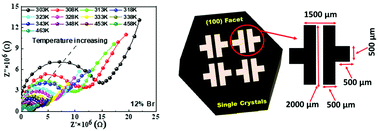Effect of bromine doping on the charge transfer, ion migration and stability of the single crystalline MAPb(BrxI1−x)3 photodetector†
Abstract
Organic–inorganic halide perovskites (OIHPs) have emerged as a promising semiconductor for the fabrication of efficient optoelectronic devices such as photodetectors (PDs). Among all the perovskite compositions, the mixed-halide MAPb(BrxI1−x)3 formulations have gained more attention for photodetection application thanks to their tunable optoelectronic properties and great stability. However, there is still a lack of sufficient understanding of the effect of Br doping on the stability and physical properties of MAPb(BrxI1−x)3 based PDs. In this work, we prepare a series of MAPb(BrxI1−x)3 (x = 0, 0.04, 0.08, 0.12, and 0.16) single crystals (SCs) and investigate the influence of the Br content on the crystal structure, charge transport, ion migration, and recombination phenomena. Moreover, self-powered PDs with a structure of Pt/MAPb(BrxI1−x)3 SC/Pt have been developed, and their optoelectrical properties at different wavelengths of light sources (blue, green, red, and white) have been studied. We found that all the PDs exhibit the highest photoresponse under white light indicating their potential for broad spectrum detection applications. Particularly, the MAPb(Br0.16I0.84)3 SC PD exhibits the highest responsivity of 2.41 mA W−1 at white light intensity, while the highest detectivity of 15.41 × 1010 Jones was observed for the MAPb(Br0.12I0.88)3 SC PD due to the smaller amount of trap states and suppressed ion migration, as proved by impedance spectroscopy. Finally, the photostability and one-year shelf-life stability of the corresponding PDs are demonstrated.



 Please wait while we load your content...
Please wait while we load your content...